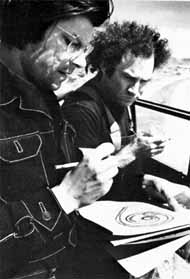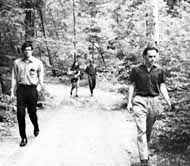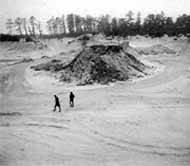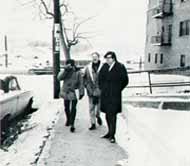
Smithson e Serra, Utah, 1970.
x

Smithson e Heizer, Portland, !968.

Andre e Simthson, Pine Barens, 1968

Kaprow, Oldenburg e Smithson, Passaic, 1968x
| concept urban situations scale interventions research arte/cidade - zona leste |
 Smithson e Serra, Utah, 1970. |
x |
||
|
|
 Andre e Simthson, Pine Barens, 1968 |
 Kaprow, Oldenburg e Smithson, Passaic, 1968x |
|
|
Robert Smithson promoted, by the end of the 60’s, several "site selection expeditions", itineraries through industrial suburban areas or large deserted spaces, which had the participation of artists as Robert Morris, Claes Oldenburg, Carl Andre, Michael Heizer, Donald Judd, Nancy Holt and Dan Graham. Expeditions that would lead to the discovery of new space configurations, complex and tensioned, totally unknown to the artistic repertoire of the time. The visits to the places were made at foot. For these artists, to walk was essential to acquire the experience of a specific place, the apprehension of its outskirts and an intensified sense of individual presence that exceeds visual perception. The phenomenological effect of walking through the space. But these very same artists already perceived the limitations of this procedure, based on the experience of vision, when matching these expeditions with operations mediated by cartography and large-scale observation. These selection strategies had been being developed, lately, by the practices of other artists. Minimalism would establish new parameters for interventions in the space. It not only would reject the anthropomorphic basis of traditional sculpture but it would refuse its separation from the site. Now, sculpture is understood in its relation with the environment and redefined in terms of place. Richard Serra and Robert Morris would redefine the principles of site specific art, redimensioning its scale: the city and observer space, and not anymore the object, become the references. The work configures a large and complex space situation. But Minimalism still considers the perception in strict phenomenological terms, as if outside history, language and power. The site was understood as specific only in formal terms, tending to be abstract and aesthetized. Then the difficulty in mapping the social and political determinations of the places and the interventions effects. The mapping operations that follow artistic practices for place tended to change directions: to map in the most recent art turned toward sociological and anthropologic aspects. The ethnographic and social framing of a community or institution becomes today the dominant form of art for urban space. The increasing demand for these more including approaches has implied in the artist’s mobilization to develop projects for cities. Artists are commissioned to develop research relative to the particularities of the city that later will be consolidated in works or documentation. The site selection is substituted by operations of negotiate, interview and organize, services given to communities and institutions or to the city administration. This kind of art is appropriated to valorize urban identities, today strongly dependents of advertising and marketing. Site-specific art attributes a distinct character to places, locational identity, indispensable quality for city promotion in the competitive restructuring process of global economic hierarchy. Placed in these reorganized spaces, art public contributes functional and aesthetically to format urban environments, encouraging real estate and revitalization projects. The artistic intervention may help to guarantee acceptance for restructuring, the contemporary form of capitalist urbanization. And to strength, when organizing corporate squares and atriums, the privatization of public spaces. It contributes to create coherence for the site, to occult its intrinsic social conflicts. Public art designs the landscape of global urban reorganization. references J. Kastner / B. Wallis, Land and Environmental Art, London,
Phaidon, 1998. |
|
x |
x | 2 | 3 | 4 | 5 | 6 | 7 | 8 | 9 |